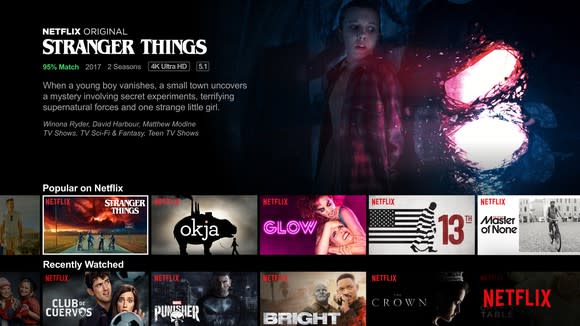Netflix Streaming Gets an AI Upgrade
For most people, Netflix (NASDAQ: NFLX) is all about the content. After all, the company is planning to spend up to $8 billion dollars this year to build out its international library of movies and TV shows. Programs like Stranger Things, The Crown, and 13 Reasons Why attracted audiences from around the world, and they have helped win the company 117 million subscribers to date.
One of the biggest contributors to Netflix's success, though, has been its cutting-edge streaming technology. This is possibly the most underappreciated aspect of the company's service. Though it doesn't attract the same level of attention as the company's hit shows like Bright or GLOW, it's likely the single most important facet of the experience, aside from content itself.
Now, Netflix's leading-edge streaming tech just got even better -- with a little help from artificial intelligence (AI).

Netflix's industry-leading technology has just gotten an upgrade. Image source: Netflix.
Of data caps and bandwidth
It's important to remember that Netflix is a technology platform used to deliver entertainment. The ability to successfully provide its customers with programming can be hampered by things like low bandwidth or data caps imposed by mobile internet providers.
Netflix is using cutting-edge AI to mitigate those issues.
Using an AI tool developed by its engineers, Netflix recently re-encoded its entire library of titles. This system, called the Dynamic Optimizer, works to provide the best possible image while using the minimum amount of bandwidth. Here's how Netflix CEO Reed Hastings described the process last year:
What we've done is invest in the codex, the video encoders, so that at a half a megabit, you get incredible picture quality on a 4- and 5-inch screen. Now, we're down in some cases to 300 kilobits and we're hoping someday to be able to get to 200 kilobits for an amazing picture. So we're getting more and more efficient at using operators' bandwidth.
This encoding process uses machine learning to review each scene and adjust the compression rate based on elements like lighting, the complexity of the scenery, and level of motion in each frame.
An hour-long episode of Jessica Jones, for example, clocks in at 750 megabits per second (Mbps) of data usage -- an amount that would wipe out the average data plan. Using Netflix's previous encoding tech, that would be reduced to 750 kilobits per second (Kbps) or 1,000 times less data usage. Recent improvements to the technology have reduced the data consumption to only 270 Kbps.

Netflix reduces data use without sacrificing image quality on shows like Jessica Jones. Image source: Netflix.
What that means to users is that a 4-gigabyte data plan will allow you to watch about 26 hours of Netflix programming per month, compared to just 10 hours using the old system. This also provides enormous benefit to subscribers in areas with low bandwidth, as it reduces buffering. It's important to note that the streaming rate adjusts to the available bandwidth, so you're not sacrificing image quality if you choose to watch on a 4K HDTV.
It's working
Netflix said that its subscribers watched a record-breaking 350 million hours of TV shows and movies on Jan. 7, 2018. Customers, on average, stream 140 million hours of programming daily, and accessed the platform using 450 million unique devices in February.
Those subscriber numbers keep growing. In its most recent quarter, Netflix added 8.3 million new customers worldwide, up 18% year over year, and the largest quarterly gains in the company's history. These additions far exceeded its expectations for 6.3 million. The company said these stronger subscriber additions were "fueled by our original content slate."
Netflix hit shows may be what drives these subscriber additions, but the technology that produces a seamless experience is what keeps viewers coming back for more.
More From The Motley Fool
Danny Vena owns shares of Netflix. The Motley Fool owns shares of and recommends Netflix. The Motley Fool has a disclosure policy.

 Yahoo Finance
Yahoo Finance 